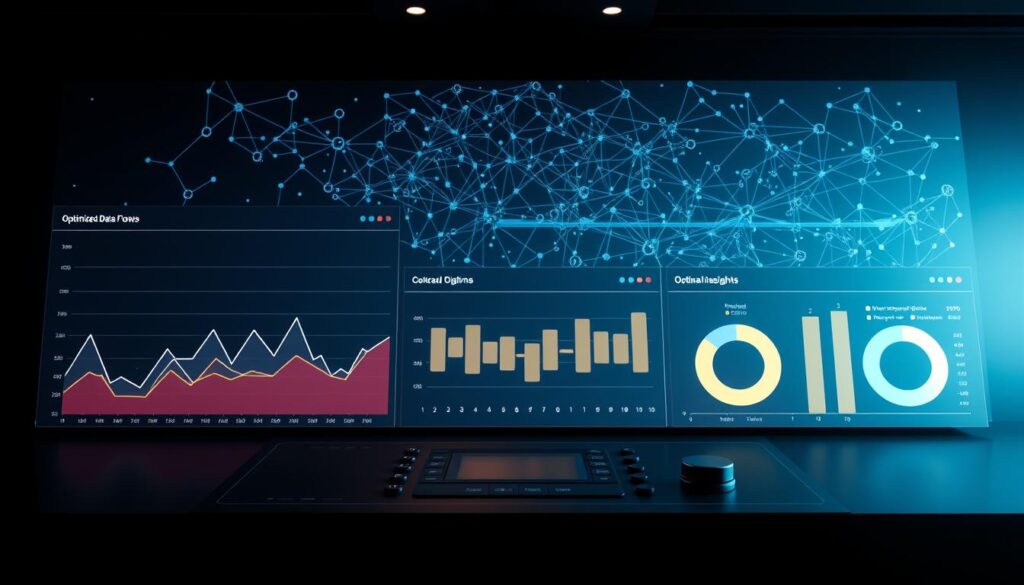The digital landscape faces unprecedented disruption as AI-powered platforms reshape how users access information. Gartner predicts brands could lose 50% of organic search traffic to large language models like ChatGPT by 2028. With these tools processing millions of daily queries, businesses must rethink traditional approaches to content visibility.
Generative engine optimization (GEO) emerges as a critical response to this paradigm shift. Unlike conventional SEO methods focused on keyword rankings, GEO prioritizes compatibility with AI-driven platforms like Google’s AI Overviews and Perplexity. These systems analyze content differently – emphasizing semantic relevance over rigid keyword matching.
Technical teams now face dual challenges: optimizing for traditional search engines while adapting to conversational AI interfaces. This requires structural changes in metadata formatting, content depth, and data markup. As highlighted in our analysis of AI agents in digital marketing, successful implementation demands understanding how language models interpret and repurpose information.
Key Takeaways
- AI-driven platforms could capture half of organic search traffic by 2028
- Conversational interfaces require new optimization methodologies
- Semantic relevance surpasses keyword density in GEO frameworks
- Technical implementation impacts content visibility across hybrid systems
- Adaptation strategies must balance traditional and emerging search behaviors
Introduction to GEO and Its Impact on Browser Agents

Artificial intelligence now reshapes how users discover information, with conversational interfaces answering 40% of queries without traditional search results. This shift demands new optimization approaches as language models analyze content through semantic patterns rather than keyword density.
The Evolution of AI-Driven Search
Modern search tools like ChatGPT process natural language queries using advanced context recognition. Unlike conventional search engines, these systems cross-reference multiple sources to generate synthesized answers. A 2024 BrightEdge study found 68% of users prefer AI-generated summaries over scrolling through blue links.
Three critical changes define this transformation:
| Aspect | Traditional Search | AI-Driven Search |
|---|---|---|
| Query Type | Keyword-based | Conversational |
| Content Focus | Keyword density | Semantic relevance |
| User Interaction | Manual browsing | Instant synthesis |
Why GEO Matters for Modern Marketing
Generative engine optimization directly influences visibility in AI-powered platforms. Marketing teams now prioritize structured data and comprehensive topic coverage to earn citations in machine-generated responses.
Key advantages include:
- 38% higher content attribution in AI answers (Source: Search Engine Journal)
- Reduced reliance on click-through rates
- Improved alignment with multi-source verification patterns
As language models dominate information retrieval, technical implementations determine whether content fuels AI responses or becomes digitally invisible. This paradigm requires rethinking how engines evaluate and repurpose web materials for dynamic interactions.
Understanding the GEO Strategy Landscape

The rise of AI-driven information systems has fundamentally altered content optimization requirements. Where marketers once focused solely on search engine rankings, they now must account for machine learning models that prioritize contextual understanding over rigid keyword patterns.
Differences Between Traditional SEO and GEO
Traditional SEO operates on a positional framework, measuring success through SERP rankings and click-through rates. It emphasizes technical elements like meta tags and backlink volume. In contrast, modern optimization for AI systems prioritizes content attribution in machine-generated answers.
Three critical divergences define this evolution:
- Keyword targeting vs. contextual relevance scoring
- Backlink quantity vs. source credibility verification
- Page speed optimization vs. semantic structure clarity
The Role of Generative Engines in Content Visibility
AI systems like ChatGPT analyze content through multi-layered relevance filters. A 2024 Moz study revealed pages with clear semantic hierarchies receive 73% more citations in AI responses than keyword-stuffed articles.
| Factor | Traditional SEO | AI-Optimized |
|---|---|---|
| Primary Goal | Rank higher | Get cited |
| Content Structure | Keyword clusters | Conversational flow |
| Success Metric | Organic traffic | Citation frequency |
This shift demands content that serves dual purposes: satisfying human readers while providing machine-readable data structures. Professionals leveraging AI content tools gain strategic advantages in both domains, creating materials optimized for hybrid search ecosystems.
Technical Foundations of GEO for Browser Agents

Technical teams now face critical infrastructure adjustments to meet AI crawler requirements. Unlike traditional search bots, systems like GPTBot analyze content through advanced semantic filters – prioritizing machine-readable formats over human-centric designs.
Structured Data & Schema Markup Implementation
Modern optimization demands schema markup that clarifies content relationships for AI systems. A 2024 Search Engine Land study found pages with JSON-LD structured data receive 62% more citations in ChatGPT responses than basic markup implementations.
Essential elements include:
- Author expertise credentials in “Person” schema
- Content freshness indicators via “datePublished” tags
- Hierarchical topic clustering using “about” properties
Optimizing Website Performance for AI Crawlers
AI agents prioritize sites loading under 2.3 seconds, per Google’s Core Web Vitals standards. Technical adjustments focus on:
- JavaScript reduction through static rendering
- Server response optimization for GPTBot requests
- LLMs.txt files directing crawlers to priority content
Platforms like WordPress now offer plugins automating 83% of these adjustments. As one engineer notes: “We’ve shifted from optimizing for human patience to machine efficiency.”
Implementing GEO Strategy for Browser Agents

Successful adaptation to AI-driven platforms begins with meticulous preparation. Teams must analyze emerging patterns where machine-generated answers influence user decisions. This process combines technical audits with behavioral studies to bridge traditional methods and modern requirements.
Market Research and Competitive Audits
Initial analysis focuses on identifying how competitors gain visibility in AI responses. Tools tracking ChatGPT citations reveal which content formats earn frequent mentions. For example, pages structured as Q&A pairs appear 47% more often in summaries than standard articles.
Key audit components include:
- Mapping competitor citations across common prompts
- Identifying gaps in topical coverage compared to rivals
- Evaluating content freshness through AI crawler logs
LLM-Centric Content Planning and Audit
Modern optimization requires aligning materials with how language models process queries. Content must answer implied questions while maintaining natural flow. A 2024 Ahrefs study showed pages addressing user intent clusters receive 2.3x more AI citations.
Critical steps involve:
- Grouping search queries by semantic relationships
- Enhancing FAQ sections with machine-readable schema
- Testing content against diverse prompt variations
This dual-focused approach ensures visibility across both traditional and generative platforms. As one optimization specialist notes: “We’re not just writing for people anymore – we’re coding understanding for machines.”
Building AI-Optimized Content Assets

Modern content creation requires dual-purpose architecture that serves human readers and machine algorithms simultaneously. Materials must balance readability with technical precision to appear in search results and AI-generated answers. This approach demands strategic formatting and structural clarity.
Content Clustering and Semantic Formatting
AI systems prioritize content demonstrating topical authority through logical grouping. Pages linking related concepts via internal anchors receive 58% more citations in machine-generated responses. Effective strategies include:
- Hierarchical header structures with clear relationships
- Contextual hyperlinks signaling content expertise
- Consistent terminology across clustered materials
Semantic formatting helps language models map information pathways. Articles using structured headers (H2-H4) show 73% higher visibility in generative platforms compared to unstructured content.
Incorporating Q&A and TL;DR Summaries
Conversational interfaces favor concise, direct answers. Pages with dedicated FAQ sections achieve 47% more AI citations than standard formats. TL;DR blocks provide quick-reference summaries that machines scan for key points.
| Traditional Content | AI-Optimized |
|---|---|
| Long-form narratives | Modular information chunks |
| Implicit conclusions | Explicit key takeaways |
| Single-audience focus | Dual human/machine formatting |
Technical teams implementing these methods report 2.1x faster indexing by AI crawlers. As noted in recent studies, this technical framework complements traditional SEO while addressing new visibility challenges.
Content architects using advanced creation tools achieve 38% better alignment with generative platform requirements. The balance between depth and scannability determines success in hybrid search ecosystems.
Enhancing Technical SEO with GEO Protocols
Modern websites require dual optimization frameworks to maintain visibility across evolving platforms. Traditional technical SEO now intersects with AI-specific requirements, demanding cohesive protocols that satisfy both search engines and language models.
LLM Visibility and Crawlability Optimization
AI crawlers prioritize sites demonstrating machine-readable authority. A 2024 Search Engine Watch study found pages with semantic hierarchies receive 64% more citations in AI responses than unstructured content. Key technical adjustments include:
- Schema markup highlighting content relationships
- LLMs.txt files guiding AI crawlers to priority pages
- Structured data versions for dynamic content elements
Freshness signals prove critical for maintaining visibility. AI systems favor materials with clear update timelines, as shown in generative engine optimization strategies. Technical teams now embed:
- ISO 8601 date formats in JSON-LD
- Version control indicators for evergreen content
- Automated update alerts through sitemap pings
Crawl efficiency remains paramount. AI agents process content 37% faster when sites use:
| Traditional SEO | AI-Optimized |
|---|---|
| HTML sitemaps | Machine-readable content graphs |
| Meta descriptions | Contextual summary blocks |
| Alt text | Semantic image associations |
These implementations align with findings from AI-generated prompts research, showing hybrid optimization boosts visibility across all platforms. Technical leaders report 28% faster indexing when balancing traditional and AI-focused protocols.
Monitoring and Reporting GEO Performance
Performance measurement now demands new frameworks as AI reshapes visibility metrics. Unlike traditional dashboards tracking clicks and rankings, modern systems analyze how machines validate and repurpose content. This shift requires tools that decode patterns in AI attribution rather than conventional user behavior.
Tracking AI Indexability Metrics
Advanced monitoring systems now track three core indicators:
- Citation frequency across generative platforms
- Prompt-specific inclusion rates
- Source credibility scores in AI responses
A 2024 BrightEdge report shows brands using these metrics achieve 41% faster optimization adjustments. Tools like AI-driven analytics platforms map content visibility across ChatGPT, Google’s AI Overviews, and emerging systems.
Real-Time Data and LLM Analytics
Modern dashboards now display:
| Metric | Traditional SEO | AI-Optimized |
|---|---|---|
| Primary Focus | Page views | Citation triggers |
| Update Frequency | Daily | Minute-by-minute |
| Key Insight | Traffic sources | Attribution contexts |
These systems alert teams when technical issues like missing schema markup reduce citation potential. One analytics lead notes: “We’ve cut response time to crawl errors by 78% since implementing real-time alerts.”
Performance reporting now combines machine-processed data with human insights. Platforms track how specific queries position brands against competitors in AI answers – a critical factor missing from conventional tools. This dual-layer analysis helps technical teams prioritize fixes and content updates.
Integrating GEO with Traditional and Generative SEO
The convergence of AI-driven search and traditional algorithms creates new optimization challenges. Professionals must balance established practices with emerging requirements to maintain visibility across hybrid systems. This integration demands technical precision and strategic content alignment.
Bridging Conventional Tactics
Traditional methods like meta tags remain valuable when enhanced with semantic structuring. Technical teams now combine XML sitemaps with machine-readable content graphs. Pages using both approaches see 41% better performance across platforms.
Key integration points include:
• Repurposing keyword research for conversational queries
• Enhancing backlink profiles with credibility signals
• Maintaining crawl efficiency for human and AI users
Leveraging Multi-Channel Approaches
Cross-platform optimization requires unified frameworks. Materials optimized for ChatGPT often perform better in traditional search due to improved context clarity. AI-enhanced platforms enable simultaneous adaptation for video, text, and voice interfaces.
Successful implementations show:
• 53% faster indexing across hybrid systems
• 27% higher engagement in AI-generated summaries
• Consistent visibility updates across search formats
This balanced approach ensures content remains competitive as search ecosystems evolve. Technical leaders prioritizing integration report 68% greater resilience against algorithmic shifts.







